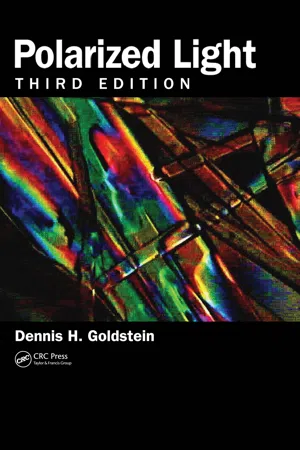
- 808 pages
- English
- ePUB (mobile friendly)
- Available on iOS & Android
Polarized Light
About this book
Polarized light is a pervasive influence in our world—and scientists and engineers in a variety of fields require the tools to understand, measure, and apply it to their advantage. Offering an in-depth examination of the subject and a description of its applications, Polarized Light, Third Edition serves as a comprehensive self-study tool complete with an extensive mathematical analysis of the Mueller matrix and coverage of Maxwell's equations.
Links Historical Developments to Current Applications and Future Innovations
This book starts with a general description of light and continues with a complete exploration of polarized light, including how it is produced and its practical applications. The author incorporates basic topics, such as polarization by refraction and reflection, polarization elements, anisotropic materials, polarization formalisms (Mueller–Stokes and Jones) and associated mathematics, and polarimetry, or the science of polarization measurement.
New to the Third Edition:
- A new introductory chapter
- Chapters on: polarized light in nature, and form birefringence
- A review of the history of polarized light, and a chapter on the interference laws of Fresnel and Arago—both completely re-written
- A new appendix on conventions used in polarized light
- New graphics, and black-and-white photos and color plates
Divided into four parts, this book covers the fundamental concepts and theoretical framework of polarized light. Next, it thoroughly explores the science of polarimetry, followed by discussion of polarized light applications. The author concludes by discussing how our polarized light framework is applied to physics concepts, such as accelerating charges and quantum systems.
Building on the solid foundation of the first two editions, this book reorganizes and updates existing material on fundamentals, theory, polarimetry, and applications. It adds new chapters, graphics, and color photos, as well as a new appendix on conventions used in polarized light. As a result, the author has re-established this book's lofty status in the pantheon of literature on this important field.
Frequently asked questions
- Essential is ideal for learners and professionals who enjoy exploring a wide range of subjects. Access the Essential Library with 800,000+ trusted titles and best-sellers across business, personal growth, and the humanities. Includes unlimited reading time and Standard Read Aloud voice.
- Complete: Perfect for advanced learners and researchers needing full, unrestricted access. Unlock 1.4M+ books across hundreds of subjects, including academic and specialized titles. The Complete Plan also includes advanced features like Premium Read Aloud and Research Assistant.
Please note we cannot support devices running on iOS 13 and Android 7 or earlier. Learn more about using the app.
Information
Part I
Introduction to Polarized Light
1
Introduction








Table of contents
- Cover
- Half Title
- Title Page
- Copyright
- Table of Contents
- Preface to the Third Edition
- Polarized Light: A History
- PART I Introduction to Polarized Light
- Chapter 1 Introduction
- Chapter 2 Polarization in the Natural Environment
- Chapter 3 Wave Equation in Classical Optics
- Chapter 4 The Polarization Ellipse
- Chapter 5 Stokes Polarization Parameters
- Chapter 6 Mueller Matrices for Polarizing Components
- Chapter 7 Fresnel Equations: Derivation and Mueller Matrix Formulation
- Chapter 8 Mathematics of the Mueller Matrix
- Chapter 9 Mueller Matrices for Dielectric Plates
- Chapter 10 The Jones Matrix Formalism
- Chapter 11 The Poincaré Sphere
- Chapter 12 Fresnel–Arago Interference Laws
- PART II Polarimetry
- Chapter 13 Introduction
- Chapter 14 Methods of Measuring Stokes Polarization Parameters
- Chapter 15 Measurement of the Characteristics of Polarizing Elements
- Chapter 16 Stokes Polarimetry
- Chapter 17 Mueller Matrix Polarimetry
- Chapter 18 Techniques in Imaging Polarimetry*
- Chapter 19 Channeled Polarimetry for Snapshot Measurements*
- PART III Applications
- Chapter 20 Introduction
- Chapter 21 Crystal Optics
- Chapter 22 Optics of Metals
- Chapter 23 Polarization Optical Elements
- Chapter 24 Ellipsometry
- Chapter 25 Form Birefringence and Meanderline Retarders
- PART IV Classical and Quantum Theory of Radiation by Accelerating Charges
- Chapter 26 Introduction to Classical and Quantum Theory of Radiation by Accelerating Charges
- Chapter 27 Maxwell’s Equations for Electromagnetic Fields
- Chapter 28 The Classical Radiation Field
- Chapter 29 Radiation Emitted by Accelerating Charges
- Chapter 30 Radiation of an Accelerating Charge in the Electromagnetic Field
- Chapter 31 The Classical Zeeman Effect
- Chapter 32 Further Applications of the Classical Radiation Theory
- Chapter 33 The Stokes Parameters and Mueller Matrices for Optical Activity and Faraday Rotation
- Chapter 34 Stokes Parameters for Quantum Systems
- Appendix A: Conventions in Polarized Light
- Appendix B: Jones and Stokes Vectors
- Appendix C: Jones and Mueller Matrices
- Appendix D: Relationships between the Jones and Mueller Matrix Elements
- Appendix E: Vector Representation of the Optical Field: Application to Optical Activity
- Bibliography
- Index